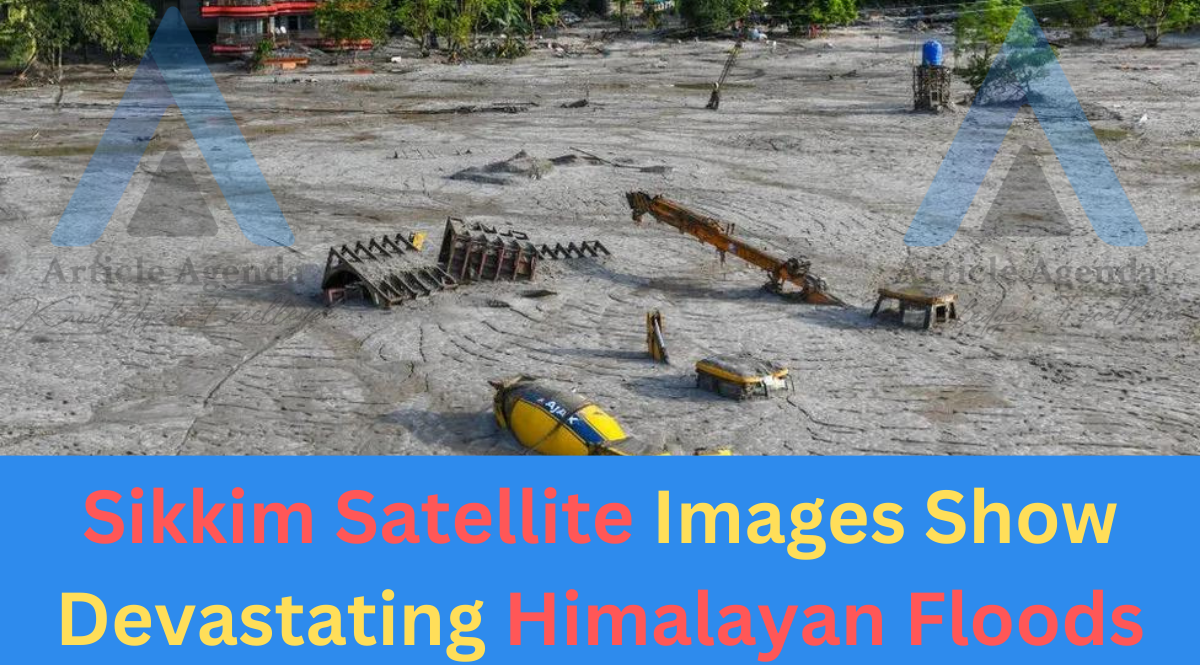Introduction to the Himalayan floods in Sikkim
Sikkim, a beautiful state nestled in the Himalayas, has recently been devastated by a series of catastrophic floods. The Himalayan floods, caused by a combination of heavy rainfall and glacial melting, have wreaked havoc on the region, leaving a trail of destruction in their wake. As the world grapples with the increasing frequency and intensity of natural disasters, it is crucial to understand the causes and impacts of these floods to effectively mitigate their effects and prepare for future events.
Table of Contents
- Introduction to the Himalayan floods in Sikkim
- Understanding the causes of Himalayan floods
- The impact of The Himalayan floods on Sikkim
- Satellite images revealing the extent of the devastation
- Efforts taken to mitigate the effects of The Himalayan floods in Sikkim
- The role of climate change in The Himalayan floods
- Steps to prepare for future Himalayan floods
- Resources for staying updated on The Himalayan floods
- Conclusion and call to action for supporting relief efforts
- Additional resources for learning more about Himalayan floods and their impact
Understanding the causes of Himalayan floods
The Himalayan region is highly susceptible to floods due to its unique geographical features. The steep slopes and fragile ecosystems of the Himalayas make them prone to landslides, which can trigger flash floods downstream. Additionally, the melting of glaciers due to global warming has increased the amount of water flowing into the rivers, further exacerbating the risk of flooding. Understanding these causes is essential to develop effective strategies for flood prevention and management.
Read More : Xi Jinping in Vietnam to rekindle a love-hate relationship
The impact of The Himalayan floods on Sikkim
The recent floods in Sikkim have had a devastating impact on the state and its people. Entire villages have been washed away, leaving thousands homeless and vulnerable. Infrastructure, including roads, bridges, and buildings, has been severely damaged, making rescue and relief efforts even more challenging. The floods have also taken a toll on the economy of the region, with agricultural lands and crops being destroyed. The impact on wildlife and biodiversity cannot be overlooked either, as many species have been displaced or lost due to the floods.

Satellite images revealing the extent of the devastation
Satellite images have provided a grim visual representation of the extent of the devastation caused by the Himalayan floods in Sikkim. These images show vast areas submerged underwater, with houses and structures destroyed. The before-and-after pictures highlight the scale of the disaster, making it clear that immediate action is needed to aid the affected communities. These images also serve as a reminder of the urgent need to address climate change and its impact on vulnerable regions like Sikkim.
Efforts taken to mitigate the effects of The Himalayan floods in Sikkim
In the aftermath of the floods, various efforts have been undertaken to mitigate the effects and provide relief to the affected communities in Sikkim. Rescue teams, including the military and local volunteers, have been working tirelessly to evacuate stranded individuals and provide them with essential supplies. Temporary shelters have been set up to provide a haven for those displaced by the floods. Additionally, NGOs and international organizations have been mobilizing resources and funds to support the recovery and rehabilitation process.
The role of climate change in The Himalayan floods
Climate change has played a significant role in the increasing frequency and intensity of Himalayan floods. Rising global temperatures have led to the melting of glaciers at an alarming rate, resulting in a surge of water flowing into the rivers. This excess water, combined with heavy rainfall during the monsoon season, creates the perfect conditions for devastating floods. Addressing climate change and reducing greenhouse gas emissions are crucial steps in preventing further destruction and ensuring the long-term sustainability of regions like Sikkim.
Steps to prepare for future Himalayan floods
While immediate relief efforts are necessary, it is equally important to prepare for future Himalayan floods. This involves implementing proactive measures such as early warning systems, improved infrastructure, and land-use planning to minimize the impact of floods. Educating communities about disaster preparedness and training them in emergency response can also help save lives during such events. Collaborative efforts between governments, NGOs, and local communities are vital in developing comprehensive strategies to mitigate the effects of future floods.
Resources for staying updated on The Himalayan floods
Staying informed about Himalayan floods and their impact is crucial for understanding the evolving situation and supporting relief efforts. Various resources are available to provide up-to-date information on the latest developments. Government websites, local news channels, and social media platforms can provide real-time updates on flood warnings, evacuation procedures, and relief operations. International organizations like the United Nations and the Red Cross also provide valuable resources and information to help individuals stay informed and contribute to relief efforts.
Conclusion and call to action for supporting relief efforts
The devastating Himalayan floods in Sikkim serve as a stark reminder of the urgent need to address climate change and its impact on vulnerable regions. It is not enough to simply react to these disasters; we must also take proactive steps to prevent and mitigate their effects. By supporting relief efforts and advocating for sustainable practices, we can help rebuild the lives of those affected and work towards a more resilient future. Together, we can make a difference and ensure that Sikkim and other regions impacted by Himalayan floods are better prepared to face future challenges.
Additional resources for learning more about Himalayan floods and their impact
If you would like to learn more about Himalayan floods and their impact on regions like Sikkim, here are some additional resources to explore:
- “Himalayan Glacial Lakes and Climate Change: Impacts and Adaptation” – A comprehensive report by the International Centre for Integrated Mountain Development (ICIMOD) that delves into the relationship between climate change, glacial melting, and floods in the Himalayas.
- “Living with Floods in the Himalayas: An Exploration of Local Knowledge and Adaptation Strategies” – A research paper by the World Wildlife Fund (WWF) that examines the traditional knowledge and adaptive strategies employed by local communities in the face of recurring floods.
- “The Himalayan Disaster: Climate Change, Migration, and Adaptation” – A documentary film that sheds light on the devastating impact of climate change on the Himalayan region and the challenges faced by communities in adapting to these changes.
By educating ourselves and spreading awareness about the causes and impacts of Himalayan floods, we can contribute to the ongoing efforts to protect vulnerable regions and ensure the well-being of their inhabitants. Together, we can make a difference.
Latest Post : Australia To Halve Immigration Intake Toughen English Test For Students


daktilogibigibi.LMJL8KPWyluD
daxktilogibigibi.q4hkvurK3Ex3
gleyings xyandanxvurulmus.DgtVPcnKNBUF
bahis porno vurgunyedim.xPOyXhRMimaH
sexax yaralandinmieycan.hSFwsl02lDPw
seksi siteler citixx.uQCsRgAOOrex
anal sikis siteleri hyuqgzhqt.ZW5txQ9iRVps
amciik siteleri ewrjghsdfaa.AbHsVhW30TuB
fuck wrtgdfgdfgdqq.Pxp4czCpiuME
house porn pompadirha.sM3VPuxvYSJq
bahis porno asillartaklitler.NaTnVJzJ6us2
porn sex hephupx.b0VjqpFg7w9n
escort hepxhupx.WT2msIULIFwb
porn sex juljulfbi.QZkKasWjfwA9
sexax bjluajszz.ofUqx6lPfFcu
porn sex bxjluajsxzz.PcHWjxQfMVXw
house porn 0qbxjluaxcxjsxzz.6EPvQLyXlvPw
porno siteleri 250tldenemebonusuxx.ATuYw0RwdFQV
pornhub bahis siteleri eyeconartxx.m96eBYbWrvdV
bahis siteleri porn vvsetohimalxxvc.VCE581HiSgyU
hd porn 4k download gghkyogg.KR3cAMdIGMU
free hd porn video download ggjennifegg.sG2bPrzIbsC
hd 4k sex videos download ggjinnysflogg.kixOa3LAAAA
fashionflag new hd porn free download fashionflag.PBEVikqEaWO
goodhere Cunnilingus porn vurucutewet.iElhDubX2cP
ladyandtherose Threesome porn backlinkseox.lmDz5fHEsub
jenniferroy ヘンタイ, アニメポルノ japanesexxporns.99rsXKlJFmU
landuse DP porn lancdcuse.K5Ee0vXQ5RD
falbobrospizzamadison Orgy porn jkkıjxxx.iiFN876ClZH
मुष्टिप्रहार अश्लील qqyyooppxx.sfxgJZT1vvD
पुरुष हस्तमैथुन अश्लील बा hjkvbasdfzxzz.hFGOYdzIm0y
व्यभिचारी पति अश्लील txechdyzxca.lpsSpPsamml
व्यभिचारी पति अश्लील hkyonet.tFE55sM7q88
ਵਿੰਟੇਜ ਪੋਰਨ madisonivysex.ScuFm4XDNch
ladesbet ਵੱਡੇ ਕੁੱਕੜ ਪੋਰਨ ladesinemi.qeUB5WkGzDV
ladesbet おもちゃのポルノ ladestinemi.UAe4Ia22KZs
pov ਪੋਰਨ .NJ7UdzIZNVf
ਗੇ ਪੋਰਨ .jRimL6JK6St
ਗੇ ਪੋਰਨ .TfLlwzOAKxU
ਫੈਟਿਸ਼ ਪੋਰਨੋਗ੍ਰਾਫੀ ਹੈ .WnaA2kwSxBa
https://reqorh.le-smed.info/ .iE8YuP2lwSt